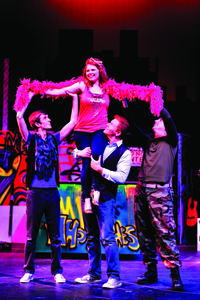

Godspell was presented by Northeast State Community College.
"I like to give my students a new challenge with each production. Theatre students need experience in a variety of performance styles, so I like to keep the season offerings varied. Also, I have to look at the talent pool, the demands of the style and period of the piece, the language requirements of the dialogue, the number of characters of different genders, the technical demands of the show, the number of sets, expense and logistics," says Bonny Gable, VI associate professor of theatre and coordinator of performing arts.
The size of the stage can also dramatically affect the choice of plays. For example, E&H routinely uses a small intimate black box stage.
"It's what it sounds like," Christianne Roll, E&H assistant professor of theatre and music, says. "The walls and floors are black, so you can create the space you need. It has lighting grids on the ceiling, and there is no set stage area." Roll is very familiar with this type of theatre, because it's what she worked in Off-Broadway.
"It's a very intimate encounter between the audience and the actors," she says. "Actors really have to be on their "A' game. They have to stay focused, and stay in the world of the show and not lose track of their goals."
This theatre at E&H does limit the size of the shows they can do. It will not accommodate a large cast.
"The largest casts we work with are 15 or so, and we prefer to work with plays that can be done on a single set, or a set that can be easily shifted from one location to another," Kelly Bremmer, E&H assistant professor of theatre, says. "We also consider the needs of our students and of our audiences. It is our goal to expose them to diverse materials, to stretch them both as performers and as theatre critics."
E&H does four shows a year: a musical, an older/period work and two others which complement the season. Northeast State is doing two performances this year. King has four performances: two main stage and two studio productions. VI stages three plays and two showcases yearly, while VHCC usually puts on three productions annually.
"We try to stretch our students with what they're seeing and expose them to different things, so that by the time they graduate they'll have a well-rounded background and résumé, plus a good liberal arts education," Roll says.
In a few years, E&H students will have a new large performing arts facility to work in. It will house two theatres (a black box and a proscenium theatre), a state-of-the-art scene and costume shop and art gallery space.
Northeast State performs in the Wellmont Center for Performing Arts, which is a large proscenium theatre. King College has a black box theatre on campus and uses the Paramount Center for the Performing Arts for larger productions. VI has three options: Trayer Theatre, the college amphitheater and the 1,000-seat Kegley Auditorium in Harrison-Jones Memorial Hall. VHCC performs in Keyser-Aday Theatre, named for Van Keyser and Gary Aday, long-time VHCC theatre professors. Aday has been with the college for 40 years. Keyser retired five years ago.
"We have a comfortable theatre which seats around 200, "Aday says. "Usually, we mount productions behind the proscenium, but seating can be configured for thrust staging and theatre-in-the-round."
A proscenium theatre is the common vision of a theatre, a stage behind an orchestra pit with the audience in front. Thrust staging has the stage extended out so that the audience is on three sides of the stage; the audience surrounds the stage in theatre-in-the-round.
Each theatre presents its own challenges. Some require a small cast, but at Northeast State's main stage they need larger casts to avoid being swallowed by the space. "We had more than 50 people in the cast when we did The Wizard of Oz," Elizabeth Sloan, head of Northeast's theatre department, says. "We do have a small theatre where we can do smaller productions. I often giggle when I walk into the theatre with the realization that this is my office. It's an amazing facility."
Rehearsals
Once the play has been chosen and the cast auditions are over, the hard work really starts. Theatre students make a major time commitment to productions.
"The rule of thumb is for every minute a play lasts, you rehearse for an hour," Sloan says. "If the play runs 120 minutes, we rehearse for 120 hours."
"We try to keep it flexible in the beginning," E&H's Roll says. "We want to make sure they have time to study, eat and get some sleep."
Sloan continues, "Sometimes we have to send them home and tell them they can't stay later or come in early. This is a nice problem to have."
Gable points out that it is more of a time commitment than just the rehearsals. "Students must also analyze their roles and study their lines outside of rehearsals, plus help with the technical duties required of the production. It is a big commitment on top of the other demands of their academic schedules, but they realize the rewards of being a part of a successful production and that makes it worth it in the end."
At VHCC, Aday points out that many more students are working and taking care of families than when he began teaching there, which makes it a bit of a scheduling challenge and requires great dedication from students.
READ ON:
>> Success